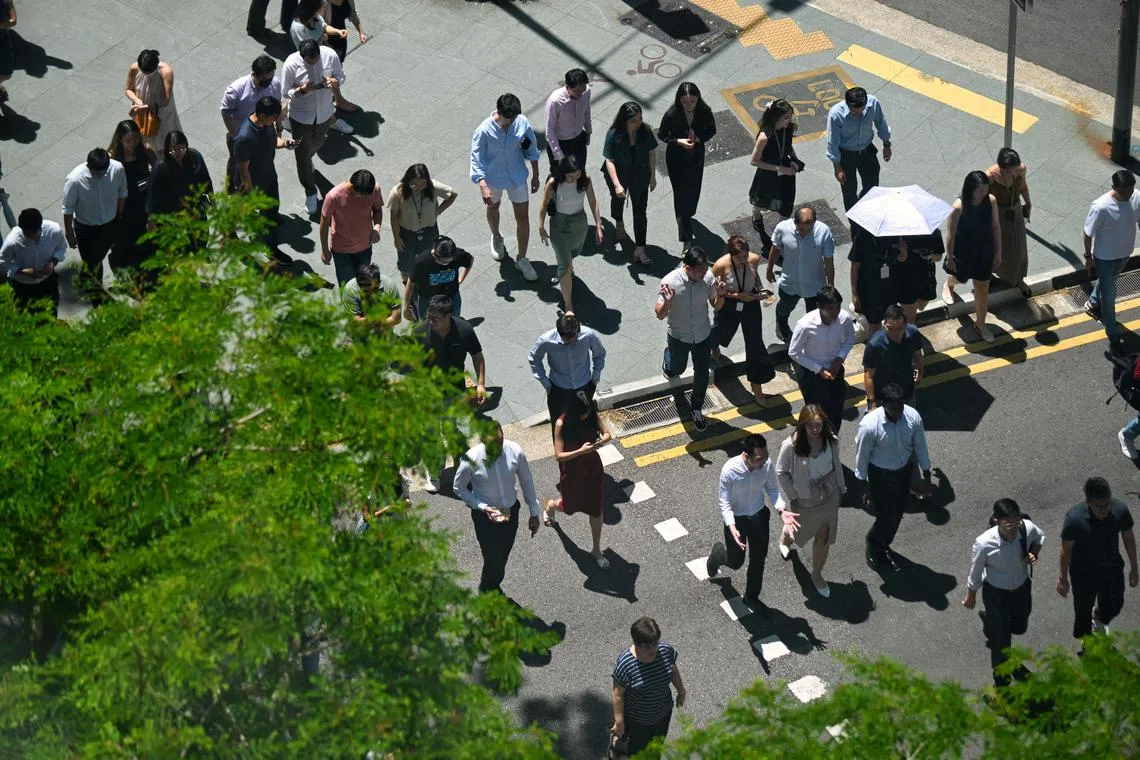Wages grew slower in 2023 than in 2022; slightly higher share of firms cut pay: MOM
Sign up now: Get ST's newsletters delivered to your inbox

Although inflation eased, real wage growth held steady from 2022, at 0.4 per cent after accounting for price changes.
ST PHOTO: KUA CHEE SIONG
Follow topic:
SINGAPORE – Wages in Singapore continued growing in 2023, albeit at a slower pace than in the year before.
As economic growth slowed and employers faced challenges maintaining profits, nominal total wages grew by 5.2 per cent in 2023, down from 6.5 per cent in 2022.
Hence, although inflation eased, real wage growth held steady from 2022, at 0.4 per cent after accounting for price changes.
These figures released by the Ministry of Manpower (MOM) on June 25 are for Singaporeans and permanent residents who worked full time for an employer for at least one year, and include employer contributions to the Central Provident Fund.
Total wages include basic wage and an annual variable component that takes into account bonuses.
The ministry said growth sectors such as information and communications, financial services, professional services, and health and social services could see higher wage growth in 2024, though increases may be tempered amid an uncertain business environment.
There continues to be strong demand for professional, managerial, executive and technical workers in these sectors.
“On balance, we expect the nominal wage growth in 2024 to remain similar to 2023.
“With inflation expected to stay on a gradually moderating trend, we expect an improvement in real wage growth,”MOM said in its report on wage practices.
The average wage rose in all industries in 2023, with the highest increases seen in the accommodation and real estate services sectors, in which wages climbed 8 per cent year on year.
Financial services followed closely behind, with a 7.6 per cent rise.
Conversely, manufacturing was the industry with the most muted growth of 4 per cent in 2023, down from 5.7 per cent in 2022.
MOM also said the below-average wage increases in manufacturing and construction came amid a slowdown in goods-producing industries affected by external headwinds such as global supply chain disruptions.
The only industry with stronger wage growth in 2023 than in 2022 was administrative and support services, the ministry noted.
MOM said the growth reflects the impact of the Progressive Wage Model.
Progressive wages, which refer to a wage ladder tied to productivity and training goals, were extended to those working in administrative roles from March 2023.
The ministry added that it expects wages in food and beverage services, administrative and support services, and retail trade to “continue growing steadily in the years ahead”, alongside the expansion of the model.
It said the 5.2 per cent overall nominal growth figure was still higher than the range seen in non-recessionary periods.
The ministry also said the proportion of profitable firms remained high at 82.1 per cent in 2023.
“However, reflecting the slower economic growth, more firms reported that they were less profitable than in 2022,” it said.
Hence, the proportion of those that gave wage increases to employees declined to 65.6 per cent in 2023, from 72.2 per cent in 2022, MOM said.
Among these firms, the average wage increased by 7.2 per cent, down from 7.9 per cent.

Meanwhile, the share of firms that cut employees’ wages rose to 6.5 per cent in 2023, from 5.2 per cent in 2022.
The average size of the pay cuts rose as well, to 6.2 per cent from 4.5 per cent.
The remaining 27.9 per cent held wages constant.
Mr Ang Boon Heng, director of MOM’s manpower research and statistics department, told reporters at a briefing on June 25 that reduced bonuses, rather than cuts in basic pay, contributed to most of the increase in the average size of pay cuts.
When grouped by seniority, wage growth moderated across rank-and-file employees, junior management and senior management, MOM added.
However, the slowdown in wage growth was more pronounced among senior management, reaching 4.6 per cent in 2023, down from 6.7 per cent in 2022.
Wage growth slowed from 5.8 per cent in 2022 to 4.8 per cent in 2023 for the rank and file, and from 7.4 per cent to 6.3 per cent for junior management.
MOM’s survey polled almost 5,500 firms with at least 10 employees from November 2023 to April 2024.
There are indications Singapore workers feel underpaid, according to a separate survey by human resources services provider ADP that was also released on June 25.
It found that 48 per cent of more than 1,900 Singapore respondents feel underpaid in their current roles, the highest across five Asia-Pacific countries polled.
Meanwhile, results of a poll of more than 670 Singapore employers by Seek, which operates the Jobstreet and JobsDB employment platforms, released on June 24, found that besides salary increments, employers are also putting in place various benefits to woo and retain employees, including special leave categories.
Examples include birthday leave, which 13 per cent of employers reported providing, as well as menstrual leave, a nascent type of leave that 5 per cent of Singapore employers provided.


